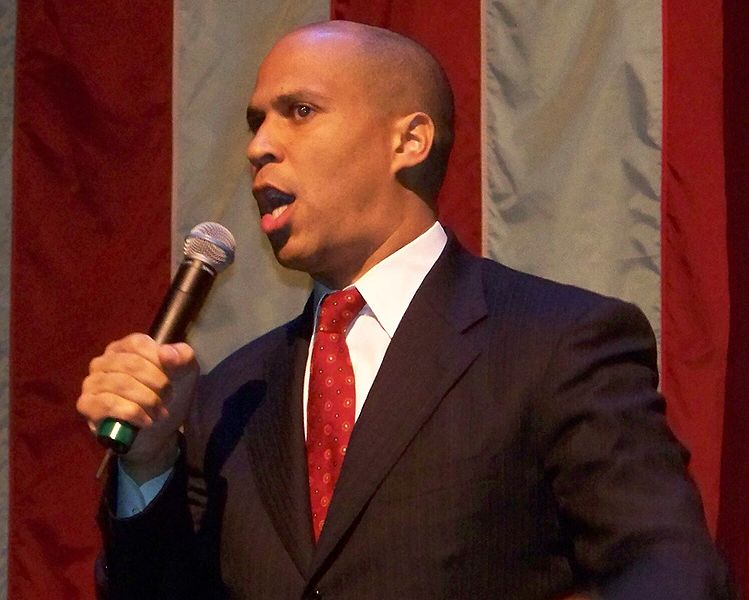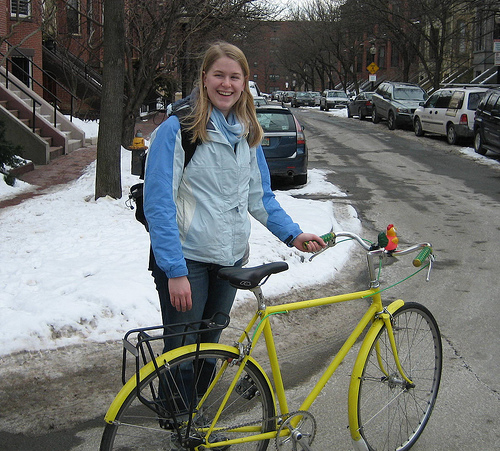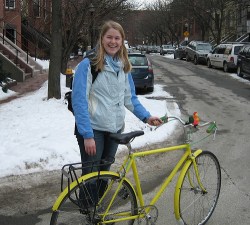Boston is infamous for its aggressive, rude, and reckless drivers. Its streets are notoriously narrow, crowded, and pockmarked with potholes. Any Bostonian worth his salt will tell you that traffic lights are nothing but impediments to vehicular progress, and speed limits are just cash-collecting scams invented by government agencies. Beantown residents are masters at running yellow lights — and those that were recently yellow.
Enter into the chaos a woman whose mission is to shoehorn a space for bikes and pedestrians into the Boston streetscape. Her main tools? Civility and kindness — uncommon methods for these parts.
Her name is Jackie Douglas, and she’s executive director of the nonprofit LivableStreets. In the past few years she, her staff, and a band of volunteers convinced officials to install bike lanes on the Boston University Bridge and strong-armed the state of Massachusetts to incorporate pedestrian needs during a $3 million bridge-building initiative, among other things. And she’s done it all with a friendly, non-confrontational approach.
“You have to work really closely behind the scenes with decisionmakers and engineers,” Douglas says of her work. “And sometimes that means you need to publicly oppose certain initiatives. But you also must come out and show support when things are going well.”
During the discussions surrounding Boston’s bridges, Douglas attended scores of lengthy public meetings. Rather than rousing a crowd to storm the meeting and lambast public officials, Douglas did most of her work ahead of time. Before the meeting, an army of volunteer bike ambassadors surveyed more than 1,500 people, collecting a lengthy list of reasons why residents wanted better bridges. Then, Douglas compiled them onto a scroll that became her prop when she commandeered the mic and began reading.
The approach took a lot of the anger out of a process that might otherwise have been ugly, and showed decisionmakers that there was solid public support for bike and pedestrian infrastructure.
During the redesign of the Longfellow Bridge — one of the most iconic in the Boston area — critics argued against merging pedestrian access with vehicles. Douglas gradually changed their minds by scouring the globe for examples of shared bike/pedestrian paths on bridges from around the world. Ultimately, she led a process that got buy-in for a bridge redesign that is “truly multi-modal.”
Jeff Rosenblum, LivableStreets founder and board member, credits Douglas’ easygoing persistence for those wins. “Success depends on strong relationships and on earning technical credibility and respect,” says Rosenblum. “Jackie nurtures relationships and builds consensus.”
Her friends in Boston aren’t the only ones to notice. Douglas’ work won her the 2011 National Advocacy Award from the Alliance for Biking & Walking, a Washington, D.C.-based nonprofit.
Douglas has also pushed for better cooperation between government agencies, particularly the state departments of transportation, economic development, and public health. It’s an approach that was pioneered under former Massachusetts Gov. Mitt Romney, and has since been emulated on the federal level under Obama.
“If you want people to change how they get around in transportation, you have to change land use,” says Douglas. “Right now we have transportation departments with zero control over land use and planning, which is how an office park gets built 100 miles outside the city.”
Under the state’s Healthy Transportation Compact, state agencies are now working to draw connections between people-centered streets and human health. Right now, they’re establishing common goals. Then they’ll identify the regulations that need to be changed and incentives that can help promote smart growth.
Rest assured that Douglas will be sitting in many of those meetings. While the LivableStreets ambassadors ponder the organization’s goals and mission during their three-hour weekly stint, Douglas has set up systems to leverage their work, stay organized, and solidify LivableStreets’s reputation as an effective, easy-to-work-with group.
But doesn’t she ever get the teensiest bit agitated by all the bureaucratic red tape? Well, yes.
“I have very little patience,” says Douglas. “If things don’t happen quickly enough, that makes me mad. But I have stamina to see things through. It’s a subtle difference. But I’m determined. I’ll stick around till it’s done.”





